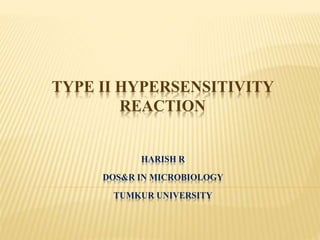
Type II hypersensitivity reaction.pptx
- 1. TYPE II HYPERSENSITIVITY REACTION HARISH R DOS&R IN MICROBIOLOGY TUMKUR UNIVERSITY
- 2. TYPE II HYPERSENSITIVITY REACTION Unlike Type I hypersensitivity, Type II hypersensitivity reaction is an immediate reaction, showing a “hyper” or exaggerated response to harmless antigens within 24 hours. Also Called As Antibody Dependent Cytotoxic Hypersensitivity Due to the interaction of antibodies and cell associated antigens, when antibodies attach to the antigens located on the surface of cells the cells becomes cytotoxic. A hypersensitivity reaction type II requires a target cell with bound antigen and antibody, which activates mechanisms to damage the target cell. It is mediated by IgG or IgM antibodies against antigens on cells or extracellular space.
- 3. TYPES OF CYTOTOXIC HYPERSENSITIVITY 1) Isoimmune reaction The reaction brought about by the Ag and Ab of two individuals belonging to the same species are called isoimmune reactions. a) Transfusion reaction The agglutination or lysis of recipient blood due to mismatched blood group is called transfusion reaction. It occurs in ABO blood group as well as Rh blood group.
- 4. TYPES OF CYTOTOXIC HYPERSENSITIVITY b) Erythroblastosisfoetails Haemolytic disease caused by the reaction of Rh- mother It occurs in the Rh+ baby developing in an Rh- mother The Rh antibody involved in this reaction belongs of IgG type. c) Transplant rejection reaction A transplant can produce antibodies to transplantation antigens these antibodies are cytotoxic to graft tissue.
- 5. 2. AUTOIMMUNE REACTIONS The reaction brought about by the interaction of an antigen and antibody of the same individual is called autoimmune reaction. Ex Autoimmune heamolyticanaemia Abs produced against its own RBC antigens. Autoimmune thyroiditis Autoimmune glomerulonephritis TYPES OF CYTOTOXIC HYPERSENSITIVITY
- 6. DRUG INDUCED HEMOLYTIC ANEMIA
- 7. COMPONENTS OF HYPERSENSITIVITY TYPE II 1) Antigen Antigens involved in type II hypersensitivity reactions are intrinsic and exogenous antigens. a) Intrinsic antigen Protein on the cell membrane, e.g., Rh ag on RBCs An antigen on a space/matrix between cells, like on a basement membrane Self-antigen (causing autoimmune diseases) Receptors antigens on cells, like hormone receptors b) Exogenous antigens Microbes, parasites, drugs Antigens of blood transfusion reaction
- 8. COMPONENTS OF HYPERSENSITIVITY TYPE II 2) Antibody Hypersensitivity type II takes place by the involvement of mainly IgG and occasionally IgM antibodies. Rarely IgA can give such reactions. 3) The effector cells The effector cells of hypersensitivity type II reaction are macrophages, neutrophils, eosinophils, and natural killer (NK) cells .
- 9. MECHANISM HYPERSENSITIVITY TYPE II Hypersensitivity type II reactions affect the cells where the target antigens are present. Hence such reactions are not often systemic. But sometimes, target antigens may be present on the surface of mobile cells like erythrocytes and leukocytes, affecting the whole body. Type II hypersensitivity has three mechanisms: 1) Antibody And Complement-mediated Lysis 2) Antibody-dependent Cell-mediated Cytotoxicity (ADCC) 3) Dysfunction Of The Target Cell.
- 10. 1) ANTIBODY AND COMPLEMENT-MEDIATED LYSIS Here, the destruction is mediated either by a complement system or antibodies via opsonization. The antibody attaches to the antigen on the surface of cells and activates the complement system via the classical pathway. This leads to the formation of membrane attack complex (MAC), which creates pores in foreign cell membranes leading to cell lysis. In opsonization, antibodies coat an antigen and make it a target for phagocytosis. Examples of this mechanism are erythroblastosis fetalis and mismatched blood transfusion
- 11. 1) ANTIBODY AND COMPLEMENT-MEDIATED LYSIS When antigen enters into host body, antibodies are produced. Antibody binds to antigen through Fab region. Fc region of antibody remains free. Phagocytic cells such as Neutrophils, macrophages and monocytes have receptors that can bind to Fc region of antibody. The receptor is known as FcR. In this case antibody molecule directly cross links antigen (Microorganism or RBC or target cell) with phagocytic cells. This cross- linkage activates phagocytic cells and increases the rate of phagocytosis. This increased rate of phagocytosis by binding of antibody to antigen is
- 12. 2) ADCC (ANTIBODY-DEPENDENT CELL- MEDIATED CYTOTOXICITY) If antigen-antibody complexes are too large to be phagocytosis, these are recognized by different immune/cytotoxic cells, like macrophages, NK cells, eosinophils, and neutrophils. These cells have Fc-receptor and, therefore, bind to the Fc region of the antibody and release cytotoxic granules on the target cell, and this causes cell death. An example of such a mechanism can be a medication acting as a hapten and binding to cells of a specific tissue.
- 13. 3) TARGET CELL DYSFUNCTION It is a non-cytotoxic mechanism. Autoantibodies binding typical cellular receptors or other proteins may interfere with the functions of these receptors or proteins and cause disease without inflammation or tissue damage. However, the cell function is impaired, causing an abnormal activation/blockade of the signaling process. Examples are Myasthenia Gravis, Graves disease, and pernicious anemia.
- 15. DIAGNOSIS AND CONTROL Diagnostic tests include detection of circulating antibody against the tissues involved and the presence of antibody and complement in the lesion (biopsy) by immunofluorescence. Antithyroid drugs, Thyroidectomy, or immunotherapy are used for Grave’s disease. Antibiotics against Streptococcus are used to control rheumatic fever. Treatment involves anti-inflammatory and immunosuppressive agents